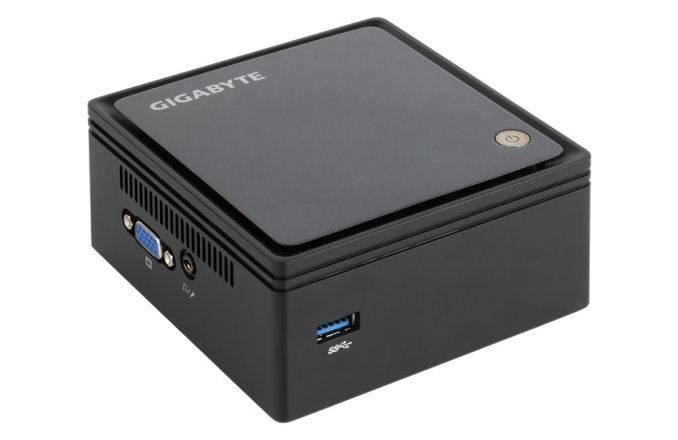GIGABYTE BRIX GB-BXBT-1900 Review: A Bay Trail UCFF PC
by Ganesh T S on October 24, 2014 12:10 PM ESTFinal Words
After putting the GB-BXBT-1900 through our mini-PC evaluation routine, we are glad to obtain additional data points that reflect what can be obtained from a system targeted towards price-conscious consumers. GIGABYTE builds upon Intel's NUC ecosystem successfully by presenting a Bay Trail alternative to consumers. Our only 'complaint' is the fact that the system is not available in the North American market (where the fanless Celeron N2807-based system is marketed instead of the BXBT-1900).
Pretty much the only downside of the unit is the bundled 802.11n WLAN component. Even considering the price-point pressures, GIGABYTE could have provided a single-stream 802.11ac card. On the plus side, the BIOS effortlessly handles overclocking transparently. The SO-DIMM we configured with was auto-clocked at 1600 MHz, despite the system's official 1333 MHz specification. The cores were also able to sustain the maximum frequency of 2.41 GHz without any user configuration. On a subjective note, the fan noise is pretty much non-existent.
All in all, GIGABYTE has managed to deliver the right balance of price, power, size and thermal / acoustic design in the GB-BXBT-1900 for the sub-$300 market.











35 Comments
View All Comments
xistic - Friday, October 24, 2014 - link
How does something like this compare to an old Intel Core Duo with 4GB of RAM? I've got a headless linux box I'm looking to replace. Currently the Core Duo is overkill for what I use it for. (Team Fortress 2 MvM, jabber, Rhodecode and Teamspeak servers all with low traffic. Seriously, never get above 20% CPU and 25% RAM consumed.)kpb321 - Friday, October 24, 2014 - link
You can see for yourself at:http://www.anandtech.com/bench/product/1227?vs=60
Single threaded performance seems to be ~half that of a Core Duo but as the J1900 is a quad core chip it's multi-threaded performance is a little bit better.
lioncat55 - Friday, October 24, 2014 - link
While I don't have any numbers that is not the right chip. You are looking at a Core 2 Duo and not a Core Due. You are also looking at a Core 2 Duo part that has a higher base clock than the J1900 has boost.A better look would be the http://www.anandtech.com/bench/product/1227?vs=64. Its bast clock is 2.4Ghz.
xistic - Friday, October 24, 2014 - link
I forgot there was a difference. It's a Core 2 Duo.xistic - Friday, October 24, 2014 - link
And thank you, this answers my question.LostAlone - Saturday, October 25, 2014 - link
Personally I wouldn't be looking to spend anything to replace a headless box unless you need more performance. I mean, I know that having a tower instead of micro-box isn't ideal, but you'd be throwing away all the benefits of having a more powerful system too, like being able to handle more traffic (say you invite a bunch of people to you TS server for a specific event) and whatever else you may possibly want to do in the future.A core 2 duo is a nice chip, and certainly would be up for doing some light media serving and transcoding duties if that's what you want to do, probably the most stressful home-server activities. Maybe that's not what you want to do right now, but having the choice to add those capabilities is great.
From my point of view moving to a system this underpowered would strictly be a downgrade. It'll cost you money to do the same exact thing you are doing now, and has none of the potential for expansion.
Ratman6161 - Sunday, October 26, 2014 - link
I don't know what they will charge for this if/when it ever comes to the US but the MSRP listed in the story is more than I paid for an Ivy Bridge i3 model a couple of years ago. Could probably get an i3 for the same or not much more and would probably be a better choice unless you needed that ability to do an internal 2.5 inch drive.zepi - Friday, October 24, 2014 - link
I'm trying to read the network performance evaluation, but i can only find that your router is 5GHz prefered, but nowhere does it state if this particular Realtek supports it or not.Often in cities 2.4GHz spectrum is totally blocked and any 5GHz is faster than 3x3 2.4GHz resticted 802.11n setup.
Ofc this is not a problem in suburbs. Basically in most places i've lived over the last few years 2.4GHz is pretty much unusable with huge packet loss and speeds down to single digit megabits due to interference from neighbours. 5GHz band is less problematic as it mostly stays inside owners walls.
Ryan Smith - Friday, October 24, 2014 - link
The Realtek radio is 2.4GHz only.ganeshts - Friday, October 24, 2014 - link
This is a 2.4 GHz only single band mPCIe card. Realtek RTL8723BEWill make a note to add single or dual band nature in the table on the first page in future articles